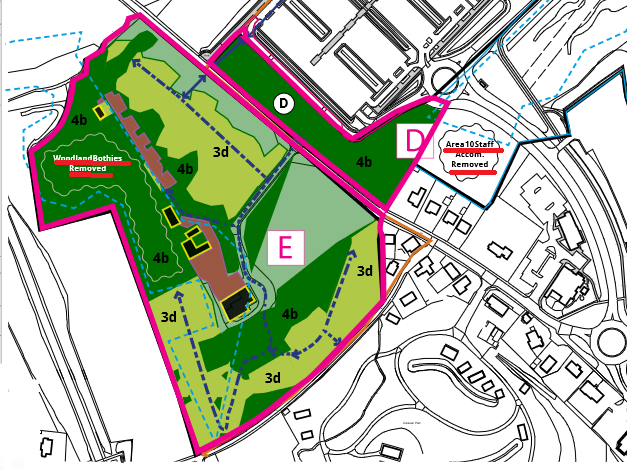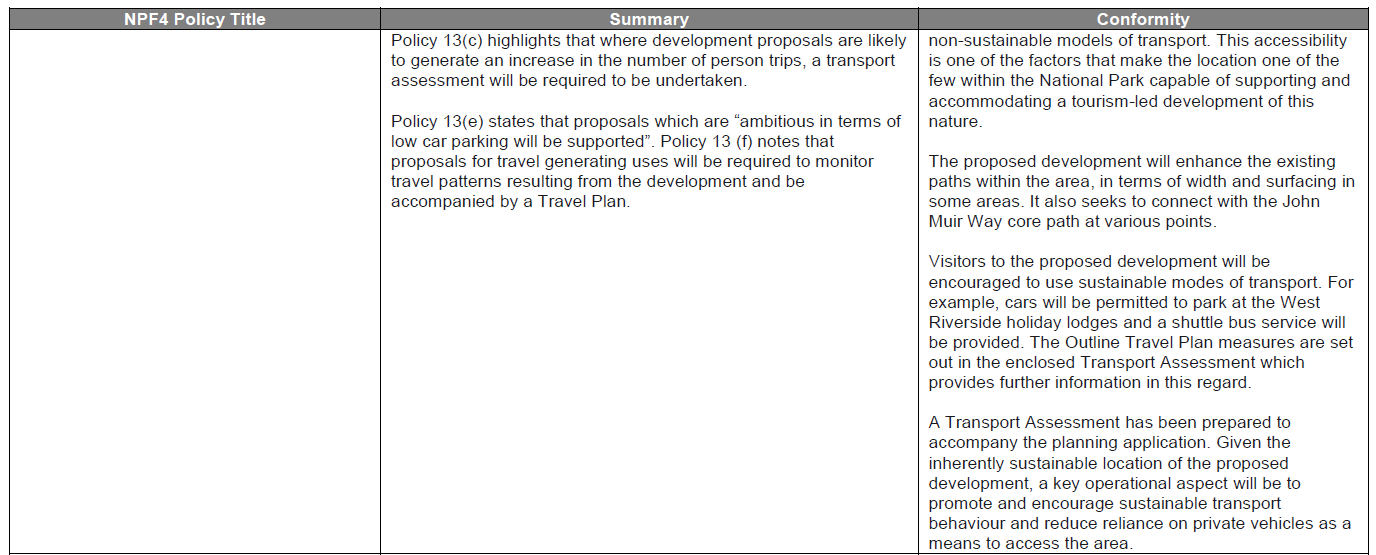On 13th February a further 42 documents were added to the planning application which Flamingo Land first submitted in May last year (see here). A cover letter from Stantec (see here) explains the main changes to the application, including which documents have been superseded, and responds to the 16 points raised by Loch Lomond and Trossachs National Park Authority (LLTNPA) in their letter of 17th November (see here).
This post will consider the main changes and some of the key points about the revised proposal. It comes part way through a planned series of posts about the original application (see here). The revised application provides no reason not to continue with that and further posts will consider in more detail:
- the landscape impact (the Landscape Visual Assessments submitted in August have been revised);
- the responses from public authorities (besides transport which I considered here);
- the revised proposals for Woodbank House and their impact
- parking (updated figures have been given on the estimated number of parking places),
- the impact that the development of the Riverside Site will have on outdoor recreation, greenspace and the local community; and
- a further look at reasons to be concerned about the planning process, including conflicts of interest.
First the good news.
Some woodland spared
Area 10, which was located in Drumkinnon Woods (see here) and was proposed for staff facilities and a service area, has been completely removed from the planning application. The only surprise, given the need to protect ancient woodland and Flamingo Land’s promise they would do so, is that the proposal lasted as long as it did.
The cover letter states that “700sqm of floorspace” will be removed and these “uses have now been incorporated into the buildings proposed in the Woodbank, Pierhead and Station Square areas” but without explaining the consequential impacts for these buildings, traffic circulation etc. Those consequences cannot just be magicked away and the LLTNPA should now ask for further details about how the proposed development will be serviced.
In addition 17 “bothies” and five lodges have been removed from the woodland to the north of Woodbank House reducing the total number of accommodation units in the development from 126 to 104. Again, this has consequences, both positive and negative. The reduction in scale of the development is again welcome, if not before time, but most of the Woodbank element of the development is now in the open “designed” landscape potentially creating a further set of problems.

The scale of the development on the Riverside part of the site, however, remains basically unchanged. As a result it will still have a significant impact on woodland as summarised by Stantec in a letter to the National Trust for Scotland:
“Overall, the direct loss of mixed broad–leaved woodland will be approximately 1.06ha (11.4%
of footprint) compared to the previous application which would have resulted in the loss of
1.33ha (17.4% of footprint). With proposed compensatory planting for each area and an
overall reduced site area, the woodland net gain would be 0.41ha (4.6%), therefore
demonstrating that the development has the spatial capacity to result in no net loss of
woodland and a gain on the existing woodland.”
No explanation is given about how long it will take this compensatory planting to compensate for the environmental and carbon losses associated with the removal of older trees.
Flamingo Land’s response to National Planning Framework 4 (NPF4)
The final question on the LLTNPA’s clarification letter in November asked Flamingo Land to evaluate their proposals against NPF4. This has now come into force and, as the LLTNPA recently explained (see here), effectively supersedes their local development plan which is now two years out of date:
“Section 13 of the Planning (Scotland) Act 2019 is now in force. This alters Section 24 of The Town and Country Planning (Scotland) Act 1997 to state that in the event of ‘any incompatibility’ between a provision of the National Planning Framework and a provision of a local development plan, whichever of them is the later in date is to prevail.
In practice this is likely to mean that some of our Local Development Plan policies will no longer apply to the same extent and, in some policy areas, greater weight will be attached to NPF4 when making decisions on planning applications.”
Stantec’s Covering Letter responds to the LLTNPA’s question about NPF4 by stating this is covered in the Updated Planning Statement (see here). As will several other revised documents this has not been fully updated and page 13 contains a long statement about NPF3 which is now redundant! However, there is also a table (pages 24-30) which lists the policies in NPF4, summarises them and then provides a brief explanation of why the applicant believes their proposals conform with Scottish Government policy:

The first two entries illustrate how much of this assessment is meaningless. The application is for Planning Permission in Principle (PPiP) and Flamingo Land has used this to avoid providing information that shows whether or not they will be able to meet the Scottish Government’s new policy requirements. Many of the responses contain the words “Whilst the proposal is not at the detailed design stage” – i.e Flamingo Land either don’t yet know or are unwilling to provide the answer – and are then followed by vague commitment to meet policy requirements. This is not good enough.
The sustainability statement, referred to in the table above, provides a good example in respect of climate change. It has not been updated since 16th May 2022 when it was first lodged with LLTNPA, i.e. well before NPF4. It is a basically a summary of things any developer (or even savvy householder) could do to reduce or mitigate carbon emissions and is full of meaningless marketing hype:
“Lomond Banks will be able to incorporate net zero concepts into every stage of development. A simple way to reduce carbon emissions is to reduce the demand for heat and electricity. Super-insulated buildings with the appropriate mechanical ventilation systems will ensure buildings can retain the heat they absorb while maintaining a pleasant environment.
It is recommended that where possible, natural light is captured and dispersed to reduce lighting
consumption during the daylight hours and that efficient LED lighting is installed to produce
appropriate levels of lighting and comfort with minimal energy consumption”
Unless they are provided with much better information it will be impossible for the LLTNPA to evaluate whether this application for PPiP could conform to NPF4 or not. For example, for emissions from buildings to be minimised not only will they need to be “super insulated”, whatever that means (there is talk of triple glazing) but heat pumps will be required. The sustainability statement goes on to say that of the three options, air source, ground source and water source, the last are the most efficient but whether they could be used at Balloch will depend “on environmental legislation and the restrictions set by the national park”. Talk about not doing any homework!
If the LLTNPA is serious about tackling climate change, the big issues such as how much heat the development will require and how this will be met need to be addressed at the PPiP stage. And if Flamingo Land cannot afford to do the right things their application should be rejected.
There are other policy areas in which Flamingo Land continue to have their head in the sand. A good example is transport which I considered two weeks ago (see here):


The changes Flamingo Land has made to the Transport Assessment, referred to in the conformity column, as a result of NPF4 have been absolutely minimal:
“The proposed reduction of 22 accommodation units at Woodbank and deletion of Area 10 does not change the outcome of the original assessment which raised no significant traffic or transport issues. No changes have been made to this chapter.”
Nothing is said in the table about how the proposed development will help deliver the Scottish Government’s commitment to reduce car journeys by 20% by 2030. Noting that Balloch is relatively well served by public transport does not make it an “inherently sustainable location” nor does it mean that visitors will arrive by train, especially if they are provided with free parking! The references to National Cycle Routes, the John Muir Way and shuttle buses on site are just flannel, an attempt to cover up f Flamingo Land’s failure to change its transport proposals as a result of NPF4.
What next?
Flamingo Land appear to be hoping that having removed two areas of woodland from the application they will satisfy the Greens and opposition to their proposals will reduce. Yet many of the fundamental issues with this development, which is still too large and will overwhelm the village of Balloch, remain.
Until the LLTNPA rejected the Loch Long fish farm application (see here) – a decision which has now been appealed by the developer – their record in applying their own policies to development proposals had been distinctly lax. Two years ago, the LLTNPA might well have given the go-ahead to this revised application. Now that appears far less likely, particularly since NPF4 has become law.
For anyone who objected to this planning application last year, it is now worth re-considering the grounds for your objection in the light of NPF4 (see here) and re-submitting it where reference to its policies, which now take precedence over those in the LLTNPA’s Local Development Plan, would strengthen your case. You can do so here. You might also consider urging the LLTNPA to evaluate Flamingo Land’s application against the policies in NFP4 at the Planning Permission in Principle and not defer this until individual detailed applications are submitted, by which time it will be impossible to change the major elements of the proposed development.
This application needs stopped.
The Loch and its green lands need to be protected, there is no suitable available infrastructure in place to support a development of this size or nature..
Loch Lomond & Trossachs National Park should be opposing this whole shambles.
It is ludicrous that a development like this could even be considered. It is grossly out of character with the whole concept of the national park in this area. this area needs to be protected and developed as a natural environment that is why people come to a national park. It will destroy valuable established woodland areas. The infrastructure in Balloch and surrounding areas will not be able to cope with such a development.